Ready to expand your horizons?
No matter what you consider your traditional market to be, it’s easier than ever before to reach beyond geographic boundaries and create a following.
“The whole world is a village at the moment,” says David Brown, president of the Edge Retail Academy. He adds that it’s not a matter any longer of adapting to local circumstances, but rather deciding how to position yourself. Get the message out that you have a unique offering and people will come to you, from far afield via the Internet or from a neighboring town.
Rather than fear the change brought about by the Internet, successful stores view it as an opportunity. “There’s too much negativity associated with the fact that we are living in dynamic and changing times,” Brown says. “Fewer stores are carving up a bigger pie. The jewelry sector is still growing. It’s still solid.”
On the following pages, we’ll explore the answers to the following frequently asked questions:

- What does it mean to be a destination store? And why are reviews so important to make that work?
- Why do I have to change the way I’ve always approached marketing?
- Does social media really make a difference?
- How can I best reach out to neighboring communities?
- What can I do that will grow my business locally as well as nationally?
The first step, says marketing expert Ben Smithee, CEO of the Smithee Group, is to take a good, hard look at your website, which will likely be shoppers’ introduction to you. Your home page should have more content about you than about the brands that you carry. What separates you from everybody else? Are there actual people shown on the staff page? What is your brand?
The second step is to make sure every customer is satisfied. Earning excellent reviews will not only reinforce your reputation but can also benefit your business in unexpected ways. Yaf Sparkle on the Lower East Side of New York City is admittedly in a huge market. Yet it’s a small operation that manages to reach well beyond Manhattan by becoming a tourist magnet. It’s been rated No. 1 for shopping experiences on tripadvisor.com based on outstanding reviews, and currently still sits at No. 4 out of 874 retail experiences in all of New York City. It has 114 reviews on Trip Advisor, with an average of 5 stars. Shoppers attest to the fantastic experience, personalized service, approachable owners and beautiful jewelry. What visitor wouldn’t want to check it out?
Third, create an authentic experience. Are you in a market that attracts a flood of seasonal visitors? According to smallbiztrends.com, “Instead of checking famous sights off a list in a guidebook, they’re seeking out the local artists, authentic foods and hidden gems recommended by friends and fellow travelers.” These are the people you want to be cross-marketing with. Yaf Sparkle owners Torsten Flaegel and Yaf Boye-Flaegel, for example, promote and cooperate with neighboring businesses. They’ve teamed up with 20 other local merchants to brainstorm on marketing and event ideas that benefit the whole coalition.
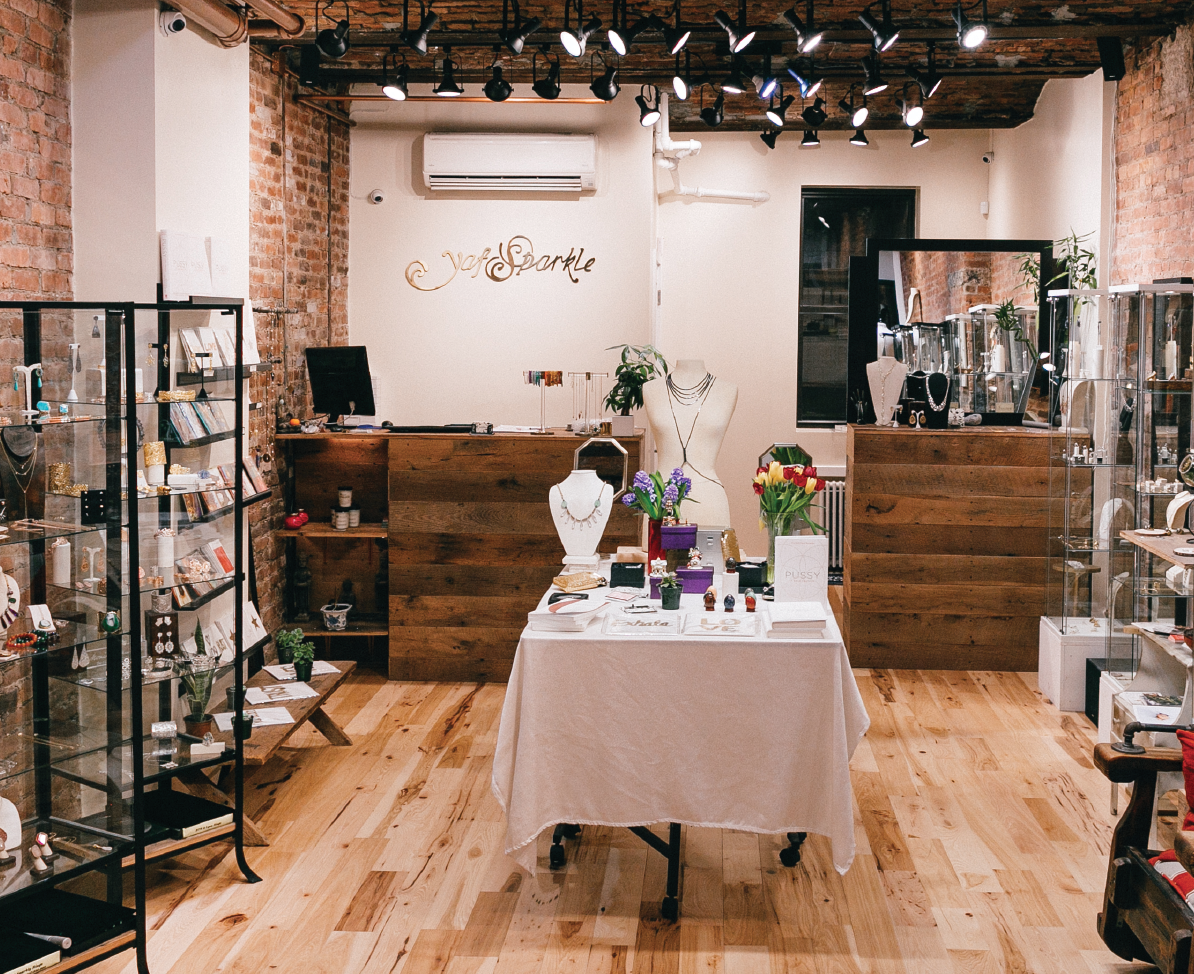
Yaf Sparkle in New York City teams with other local merchants for cross-promotion.
Ashley Porter of Porter Lyons in New Orleans — a city that attracted close to 11 million visitors in 2017 — has found a way to compete with myriad jewelry stores in the tourist-dominated French Quarter by setting her product apart. She offers jewelry that oozes local flavor without climbing on the bandwagon to sell ubiquitous fleur de lis pendant souvenirs. One of her popular collections is based on an alligator’s backbone and the skull of a coypu, or giant water rat. Another collection has a voodoo theme. New people find her store every day and about 15 percent of her business is e-commerce.
Half of the customers at Croghan’s Jewelry Box in Charleston, SC, are from out of town. Their Goldbug collection of cockroach-themed jewelry has garnered attention from Southern Living Magazine, the Atlanta Journal Constitution, Brides, Luxe Magazine and vogue.com, among other outlets. The Palmetto bug line was designed by fourth-generation jeweler Mini Hay, a sculpture and art major, who was challenged with coming up with a fun item that would be collected by locals and tourists alike. The Goldbug collection is also sold wholesale to more than 25 stores across the country.
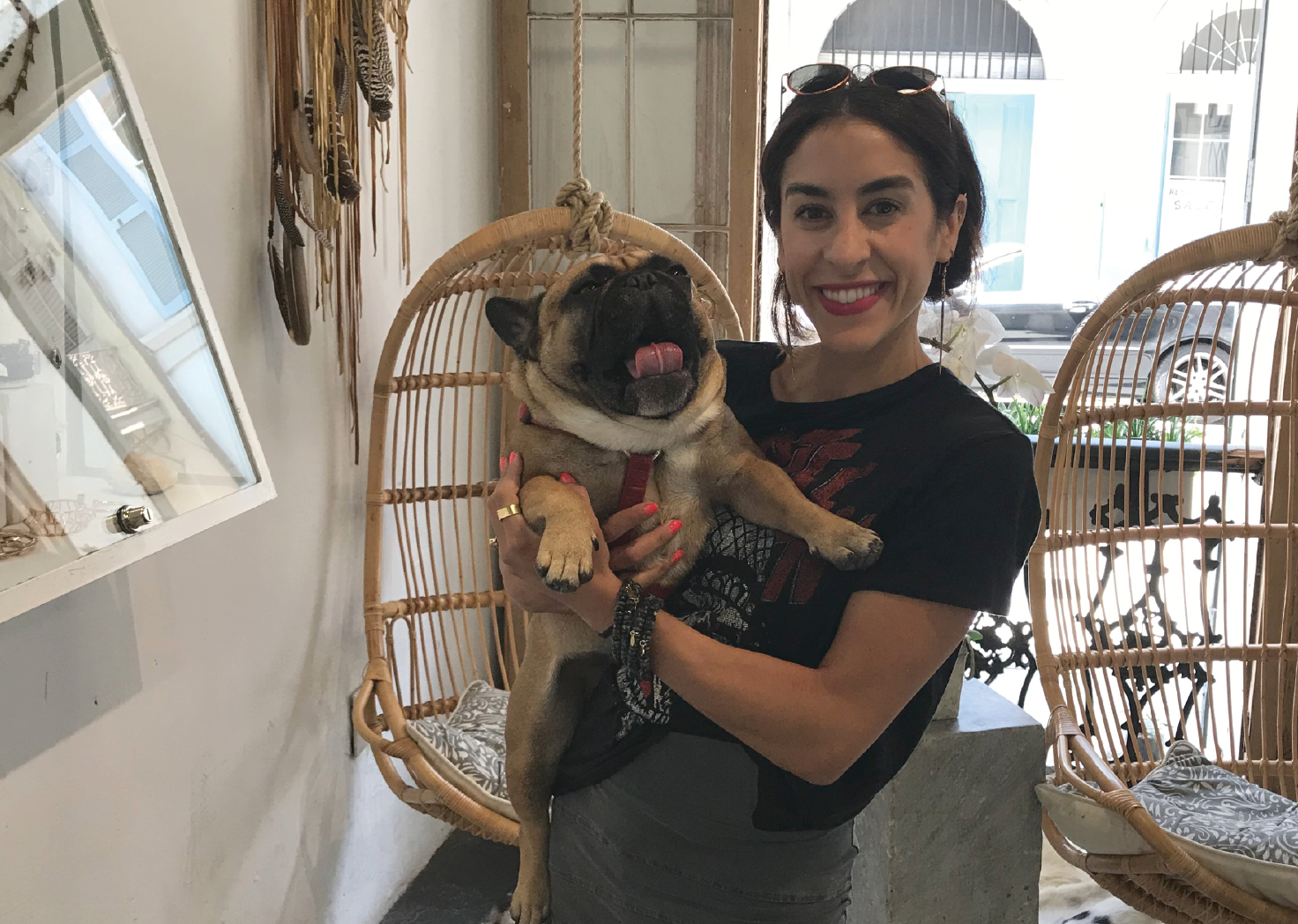
Ashley Porter and her “greeter,” Gaston, promote New Orleans-flavored jewelry without being cheesy.
Fourth, find a specialty. “Often retail jewelers become generalists, doing a little bit of this, a little bit of that — from bridal to repairs,” says Brown. They kind of dabble as opposed to specializing. Don’t try to be all things to all people.”
 Retailers become generalists, doing a little bit of this, a little bit of that … Don’t try to be all things to all people.”
Retailers become generalists, doing a little bit of this, a little bit of that … Don’t try to be all things to all people.”
— David Brown
Louise Rogers of Rogers Gallery in Mattapoisette, MA (pop. 6,045) created a tribe of followers by becoming Trollbeads central in the United States. Not only is she an authority on the brand, but she’s preparing to host her ninth annual national Trollbeads Festival, which draws visitors from all over the country. To get there, she gave it her all — 12 hours a day, seven days a week spent on Twitter, Facebook, the website and then, finally, a forum she started for fans of the brand — trollbeadsgalleryforum.ning.com. It doesn’t stop with the fest, though. Rogers Gallery has the largest selection of Trollbeads in any one gallery and specializes in unique and retired Trollbeads. Collectors are loyal to the store and the website, which is updated daily.
Fifth, consider whether there’s anything special about your area and tie it in with something people can relate to. Sarini Fine Jewelry is an accidental tourist attraction in the small town of Vulcan, Alberta, Canada. Sandra Locken’s building is located next to the bust of Leonard Nimoy (Mr. Spock from Star Trek, who was a Vulcan). “We always go out and offer to take photos for visitors next to the bust, and we’ve met people from all over the world who came to visit Spock.” They’ve even delivered jewelry (and spoken Klingon) for a Star Trek-themed wedding.
FAQ: Reaching Your Store’s Full Potential

 I hear about digital marketing every time I turn around, from consultants, experts and even my peers, but can it really make a significant difference in my bottom line?
I hear about digital marketing every time I turn around, from consultants, experts and even my peers, but can it really make a significant difference in my bottom line?

Before Kevin Mays of John Mays Jewelers in Fort Smith, AR (pop. 87,400) met marketing consultant Ben Smithee at the American Gem Society Conclave a couple of years ago, Mays Jewelers didn’t have an Instagram page, its website was weak and Facebook was in limbo, Mays admits.
Smithee challenged him to start doing a couple of things immediately that would cost him nothing: Post daily to two social media platforms he already had toyed with, and focus on relevant local hashtags. “That’s all I did,” Mays says. “I didn’t spend a penny.” And still, within six months, John Mays Jewelers had picked up an extra month’s worth of business. When the family-owned business began putting some marketing dollars behind their digital presence last year, they picked up an extra quarter of business.
The change is noticeable. Every week, someone comes by to show them a post or a digital ad depicting a piece of jewelry they’d like to see in person. More and more business is done over the phone from far-flung locales. And Mays recently sold his first 3-carat diamond via text.
“Our main goal is to get people into the store and get them interested in what they see in the store,” Mays says, but there’s been a bonus effect. Since he began concentrating on digital marketing, he’s drawn customers from all over the world. He has followers in New York, Dallas and LA. And, although Mays has not introduced e-commerce, out-of-towners don’t seem to mind picking up the phone. “They call and we’ll get it sent to them,” Mays says.
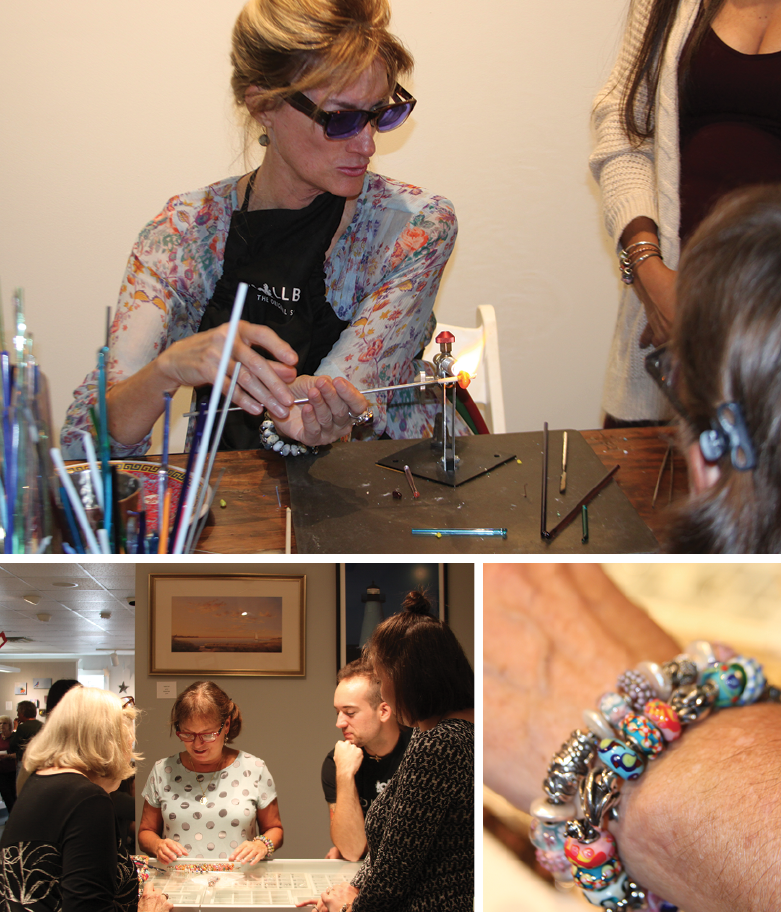
Every year, serious collectors of Trollbeads converge on Rogers Gallery in Mattapoisette, MA, for the Trollbeads Festival.
All of this represented a big change for the business, which opened in 1999. “We stuck to traditional things,” Mays says. “But recently, those things were not playing out and they were costing more and more. It took a while to convince my father that you can make money on mobile phones.” Once everyone was on board, it became clear it was time to revamp the marketing budget. All of Mays’ vendors have high quality photos and videos, so he takes advantage of that. He’s also started shooting his own videos.
“The learning curve never ends,” Mays says. “It’s pretty steep if you ask me. But Ben and his team have taught me you’ve got to keep it fun and interesting. It’s not necessarily about posting all day long. It’s about when you post and what you post and having a constant presence. Every dollar counts and how you spend it counts.”
There’s still a place for traditional advertising, from billboards to TV and newspaper. Mays also writes a column for a local magazine. “You have to balance your budget accordingly. Digital has vastly improved our whole marketing campaign. You can instantly track it and see results. You don’t have to wait till the end of the fourth quarter to see how many eyeballs you had.”
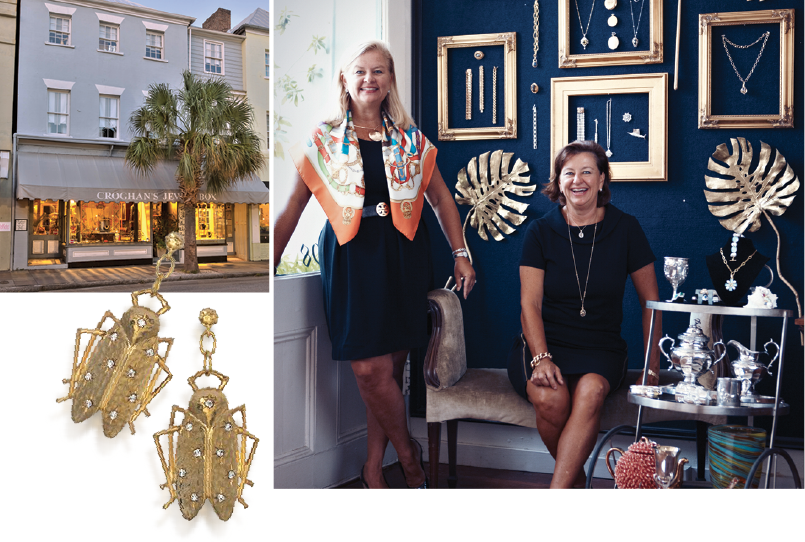 Mariana Ramsay Hay and Rhett Ramsay Outten own Croghan’s Jewel Box, where cockroach-themed jewelry is a big hit.
Mariana Ramsay Hay and Rhett Ramsay Outten own Croghan’s Jewel Box, where cockroach-themed jewelry is a big hit.
But not everyone has been as receptive as Mays to what consultants like Smithee are saying. “People are seeing digital as something they have to do, rather than as a new opportunity,” Smithee says. “It’s not the future; it’s today. But it almost seems like 50 percent of our industry feels like it’s a nuisance or an evil thing.”
Smithee advises clients to take the next step with e-commerce. “E-commerce is the future. And not just for finished jewelry but for custom, too, so you need a seamless experiences online,” he says. “If it’s not on your radar, you’re asleep at the wheel.”
Retail jewelers in markets of any size can learn something about the value of both social media marketing and custom e-commerce from Tim Andre, sole proprietor of Emma Parker Diamonds in Lynnwood, WA (pop. 38,000).
Although he’s just about 17 miles from Seattle, he has no walk-in traffic and he’s not looking for it. As a solo act, he relies on appointments and the Internet to sell customizable engagement rings all over the world. “It’s just me, so there’s no way I can deal with walk-ins while I have appointments,” Andre explains. The 20 percent of clients who make an appointment are usually sold before they walk in. One customer who made an appointment asked to see one diamond ring and immediately handed Andre his credit card. Still, if they want to linger, they’re invited to relax, view options and enjoy a Scotch or a glass of wine.
How is this possible? “It’s a dance of social media and a really captivating website with a lot of options. But the biggest thing is just being flexible. There’s pretty much nothing we won’t try to do for a client, from working on a custom design to answering 10,000 questions” to offering popular options like lab-created diamonds. Rather than buying into jewelry lines, he works with boutique suppliers who realize that the way to do business with him is to help him get exactly what customers want, rather than forcing him to commit to certain standard settings that might languish on a shelf.
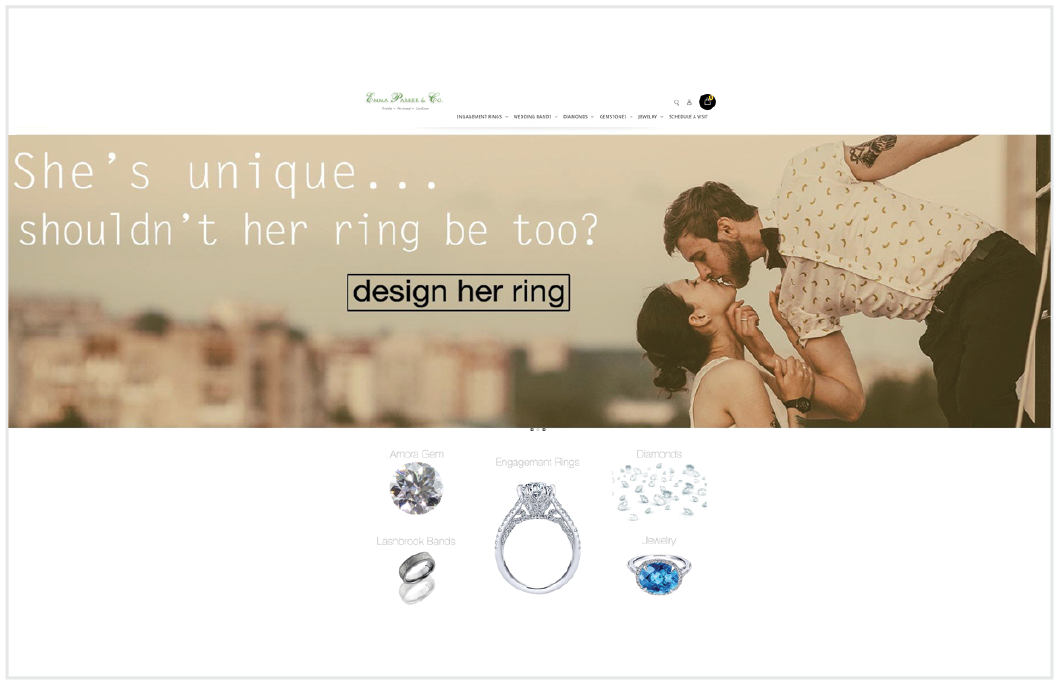 Online design tools simplify ring buying for clients of Emma Parker near Seattle.
Online design tools simplify ring buying for clients of Emma Parker near Seattle.
Pinterest is the driving force. He posts seven to 12 pins every day with the volunteer help of his wife, Tara, and his pins get 300,000 views in a month. On the other hand, his 28,000 Facebook followers seem to have little impact on his business. “Pinterest is everywhere and reviews are king,” he says. “We have 150 five star reviews and two four stars, which I’m very upset about. But we have zero bad reviews anywhere — The Knot, Yelp, Google, Wedding Wire. When I have a customer who has something go wrong, we will move heaven and earth to make sure they are satisfied at the end of the day. One bad review could cost you $100,000 over 10 years!”
Whatever you try with social, be consistent, Andre advises. “I could put up the most brilliant sets of posts, but if I don’t do it regularly, it can make zero impact.”
Sandra Locken of Sarini Fine Jewellery has a 750 square foot shop in Vulcan, (pop 19,000) a rural area of Alberta. In 2010, she and her husband purchased and gutted one of Vulcan’s first bank buildings and transformed it into a boutique. In 2016, she stopped nearly all traditional marketing. It felt risky, partly because her main two competitors battle it out to see who can own traditional local media. “We re-evaluated how much money we were spending and our rate of return and decided there was a lot of money going out the door to advertise, but it was our social media and relationships that were bringing people in the door,” Locken says.
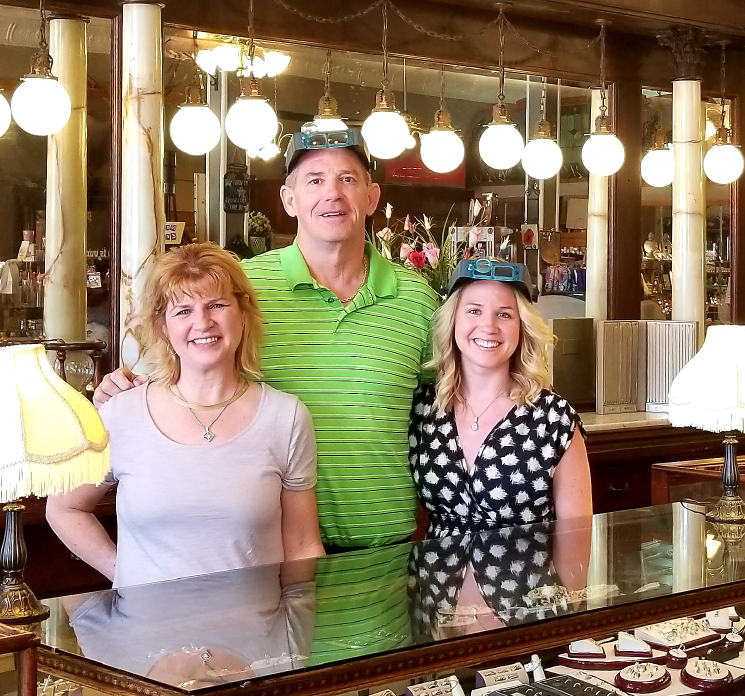 Kim and Russ Kathol and daughter DeAnne take their jewelry store on the road twice a year.
Kim and Russ Kathol and daughter DeAnne take their jewelry store on the road twice a year.
“It was super scary at first.” Immediately, though, she realized a 24 percent increase in sales during an economic downtown. The custom side of the business increased by 150 percent within a year. By fall 2017, Locken was selling jewelry on Instagram and her audience had expanded well beyond her town. “With social media, we’re reaching customers we wouldn’t normally think of. We’ve had three custom jobs from clients in Texas.”
 How can I reach out more effectively to surrounding communities that may not have a jeweler of their own?
How can I reach out more effectively to surrounding communities that may not have a jeweler of their own?

Russ Kathol of Main Street Jewelers in Plattsmouth, NE (pop 6,000) has grown a secondary market with a pop-up shop 180 miles away from Plattsmouth in Russ’ hometown, a rural community with a population of 1,400 that hasn’t had its own jewelry store in 25 years. Every April and November, Russ, Kim and daughter DeAnne pack up the truck and trailer and make the journey with as much inventory as their insurance policy will allow packed into portable jewelry cases. They rent a storefront, offer custom design and jewelry repair and build up trust one consultation at a time.
Russ was inspired to try it because every time he made the trip home to visit family, people stopped by anyway to consult with him about repairs, an upcoming special occasion, or the value of inherited jewelry. It helps that Russ grew up there. He says he is often recognized either as “an ornery former student” by teachers or a trustworthy family friend. One purpose of their visit is to provide six-month jewelry checks. The first time they made the trip, they were inundated with customers; repairs and follow-up sales brought in $50,000. Now each trip represents at least $100,000 in revenue, eventually, if not on the spot.
 Nobody ever leaves us feeling like they don’t have anything of value. We’ll run costume jewelry through the cleaner when we can.” — Russ Kathol
Nobody ever leaves us feeling like they don’t have anything of value. We’ll run costume jewelry through the cleaner when we can.” — Russ Kathol
“It’s mostly a repair event; the closest jeweler is 40 miles away and maintenance is often an issue,” he says. “Often, things haven’t been checked or cleaned in years.” It’s also about helping sort out, evaluate and discuss remounting estate jewelry. A staff member returns to the town two weeks later and delivers 50 to 60 repair items door to door, which saves money on shipping.
The rural community can represent wealth in farmland and real estate, so it’s not uncommon to make some impressive sales, particularly in November, after the crops have come in. If someone is going to make a significant purchase — $15,000 or $20,000 — Russ sets up a separate appointment with them at a later date.
They make time for everyone, no matter the value of their estate jewelry. The event has an element of Antiques Roadshow to it, because many people have no idea what their jewelry might be worth. “I’ve seen a 3.5-carat European cut diamond ring, and they have no clue what they have. If a dishonest person went in there, they could offer the owner $300; we gave her $30,000 for it.”
On the opposite end of the monetary value spectrum with off-the-charts sentimental value was a 1940s-era engagement ring. A man in his 90s pulled out a vintage ring box and said the ring had never been worn. His brother bought it overseas during World War II but his girlfriend dumped him. He put it in a safe deposit box for the rest of his life and his brother inherited it. Kathol bought it, and although it had a retail value of only about $600, one of his customers bought it for its story and put it in a safe deposit box. “It’s amazing how people value this stuff,” Kathol says. “These people own many millions of dollars of farmland, and they keep inherited pieces of jewelry worth less than $1,000 in safe deposit boxes. But nobody ever leaves us feeling like they don’t have anything of value. We’ll run costume jewelry through the cleaner when we can.”
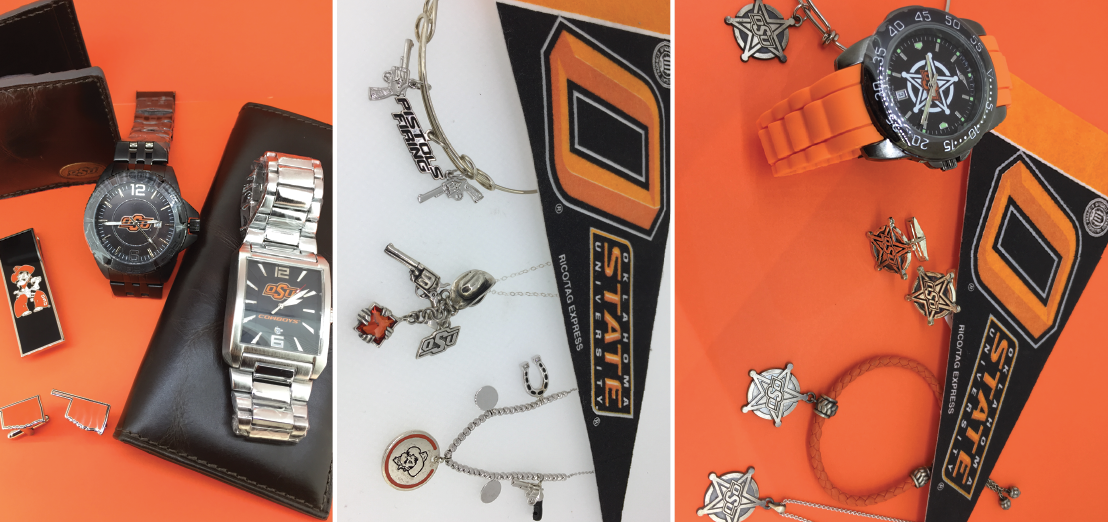
Twenty-five percent of Leonard Jewelry’s sales represent collegiate-themed jewelry, from the subtle to the more obvious.
Next time they return, they’ll rent a larger facility and invite complementary businesses, like a winery and a boutique, to join them.
Back home in Plattsmouth they draw customers from Omaha, 12 miles away, who are looking for small-town service. They’ve diversified their business to include 3,000 square feet of giftware and a separate gun shop. They rent tuxedoes, which attracts a large majority of the community’s youth, come prom time. “They come into the store three times — to get measured, pick up the tux and return it. They find out that it’s not intimidating to come to the jewelry store. We’re growing with the younger families.”
Mark Snyder of Snyder Jewelers of Weymouth, MA (pop. 55,000) didn’t have to look far to find opportunity. The town of Abington, MA, is a few miles down the road and it hasn’t had its own jewelry store in 20 years. He hired a marketing expert from Abington who made it her mission to introduce Snyder to Abington. Snyder sponsored local sports, music and high school programs, partnered with a high school to create lapel pins for its hall of fame program, and marched in parades. They reached out to first responders, invited residents to all of their in-store events and offered a first-time shoppers’ discount. They gave away watches to male high school hall of famers and charm bracelets to the girls. They also targeted Facebook advertising to the zip codes and demographics they wanted to reach and sent direct mail and thank-you cards using their EDGE program.
 Collegiate jewelry is the step into the store, but the attraction becomes buying our jewelry in general over time.” — Annette Kinzie
Collegiate jewelry is the step into the store, but the attraction becomes buying our jewelry in general over time.” — Annette Kinzie
It worked. Since they started the campaign a few years ago, they’ve added 300 loyal Abington customers to their database. He’s also targeted his hometown and a couple of other towns in the area. “We’re as busy as we’ve ever been,” he says.
 What can I do to promote my store locally as well as grow a following outside of my town?
What can I do to promote my store locally as well as grow a following outside of my town?

For Leonard Jewelry in Stillwater, OK (pop. 49,500), football was key. About nine years ago, Annette Kinzie of Leonard Jewelry was invited by a supplier to begin promoting and selling collegiate jewelry for the local state university. Kinzie and company ran with the concept and made it their own by creating fine custom jewelry in OSU’s colors, essentially offering something for every fan at every price point. And they set up shop in the stadium on game days, advertised in the football guide, and created monthly store videos to promote their endeavor. “It’s put us in touch with alumni all over the United States,” she says.
About 25 percent of their business is collegiate jewelry focused on football season. Some of what they sell is licensed OSU jewelry, but Kinzie combines the symbols, logos and colors with other jewelry styles to customize them. While some customers want the jewelry to spell out OSU, others want a more subtle statement — the colors in a wide range of orange gemstones (such as sapphires, spessartite garnet and orange chalcedony), black and white gemstones or CZs.

Leonard Jewelry’s Annette Kinzie poses in front of the store’s collegiate jewelry displays.
The fact that so much of their OSU jewelry is exclusive to their business makes a big difference. “We continue to offer new things and keep it fresh, and also just promote the heck out of it,” Kinzie says. When shoppers realize the jewelry is sterling silver or gold, they generally embrace the product along with the price. “They’re excited because it’s different than anything they have seen before. It’s unique and it shows their school pride.”
Each year on the Friday before the homecoming game, Stillwater hosts a “walk-around” that attracts thousands of people to view fraternity house decorations. So they set up a booth during that event and then again Saturday at the game. “We have gained some excellent customers who would have never walked into our store otherwise, because they live in different cities or out of state,” Kinzie says. “Collegiate jewelry is the step into the store, but the attraction becomes buying our jewelry in general over time.”